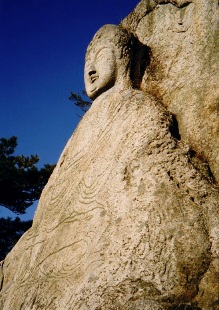Silla
| Silla | |
|---|---|
| Korean Name | |
| Revised Romanization | Silla |
| McCune-Reischauer | Shilla |
| Hangul | 신라 |
| Hanja | 新羅 |
| Silla Tombs in Gyeongju | |
This article is about the ancient Korean kingdom of Silla. For the municipality of the same name in Spain, please see Silla, Valencia.
Silla was one of the three kingdoms of ancient Korea. Silla conquered the other two kingdoms in the 7th century C.E., Baekje in 660 and Goguryeo in 668. Historians sometimes refer to Silla in the period after it conquered the other two kingdoms as Unified Silla.
It is believed that Silla was founded by Bak Hyeokgeose in 57 BC. By the 2nd century, it existed as a distinct confederation in the south east of Korea. King Naemul (356-402) established a hereditary monarchy. By annexing the eastern half of the kingdom of Gaya state in the 6th century, Silla emerged as a fully grown kingdom.
| History of Korea |
|---|
 |
| Timeline |
|
|
King Jinheung (540-576) established a strong military force. In the 7th century Silla allied itself with the Chinese Tang dynasty. In 660, under King Muyeol (654-661), Silla subjugated the kingdom of Baekje. In 668, under King Munmu (King Muyeol's successor) and the famous General Kim Yu-shin, Silla conquered Goguryeo in the north. After this Silla fought for almost a decade to expel the Chinese forces and established a unified kingdom in Korea.
The capital of the Silla kingdom was Gyeongju (慶州). A great number of Silla tombs can still be found in the centre of Gyeongju. Silla tombs took the form of a stone chamber tomb which was surrounded by a soil mound. A great number of remains from the Silla period can be found all over Gyeongju. The historic area around Gyeongju was added to the UNESCO World Heritage list in 2000. Much of it is also protected as part of Gyeongju National Park.
The Bronze Bell of King Seongdeok the Great attracts a large number of national tourists. The bell produces a distinctive sound, about which there is a legend. The Cheomseongdae astronomical observatory near Gyeongju is remarkable for its time. It is built out of 362 stone bricks which represent the 362 days of the lunar year.
The importance of Buddhism is reflected by many buddhist carvings left behind by Buddhist monks, mostly on Mt. Namsan. These statues and reliefs are carved in stone, which meant that many have been preserved over the centuries.
Culture
Buddhism was supported by the state and flourished in Silla. A great number of temples was built, the most notable probably being Hwangyongsa, Pulguksa and Sokkuram. Silla attached great importance to the pagoda. Sillas wooden pagodas were later replaced by stone constructions.
From at least the 6th century, when Silla acquired a detailed system of law and governance, social status and official advancement were dictated by the bone rank system. This rigid lineage-based system also dictated clothing, house size and the permitted range of marriage.





